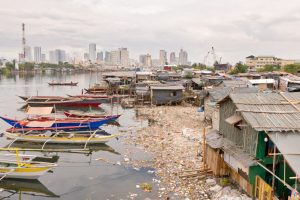More Filipinos are poorer today compared to 2018, according to the latest official data released by the Philippine Statistics Authority (PSA).
Citing its Family Income and Expenditure Survey, the PSA said the country has 19.99 million individuals living below the poverty threshold. This represents 18.1 percent of the population. In 2018, there were 17.67 million poor Filipinos. Meanwhile, the number of “food-poor” individuals increased by 1.01 million. The PSA also reported a 7.8 percent unemployment rate, which is equivalent to 3.71 million jobless Filipinos.
The poverty situation could be worse because the PSA survey was done in 2021, and its poverty threshold is considered unrealistic by other experts. Converted into U.S. dollars, a person belonging to a family of five members only needs to earn $1.41 per day in order to survive and meet his or her daily food requirements, according to the Philippine government.
House of Representatives Deputy Speaker Ralph Recto, who is a former senator and former head of the National Economic and Development Authority, chided the PSA for using a low food threshold cost to measure poverty.
“I do not know what sample meals were cooked by the PSA people in their test kitchens which prompted them to issue that food threshold cost. Maybe the PSA would like to share their miracle recipe for the enlightenment of families who are having a hard time putting food on the table and making ends meet,” he commented sarcastically.
In an editorial, the Manila Times advised the PSA to adopt the global standard for determining the country’s state of poverty.
“Reducing and ideally eliminating poverty is an aspiration of every administration, but no administration will be successful if it does not fully understand the scope of the problem. It cannot possibly do so given the inadequacy of the data indicators it is given to work with under the current model used by the PSA,” it stated in an editorial.
Independent think-tank Ibon Foundation pointed out that “the reality of daily poverty is being made invisible to official statistics.” It urged the government to reconsider its methodology in counting the poor and aim to uplift the conditions of more Filipinos and not just those categorized to be living on extreme subsistence levels.
“The government can and should have a more expansive view. A high poverty threshold can be the expression of ambition to raise more Filipinos, not just the extremely poor, out of their daily lived experience of poverty,” Ibon said.
For its part, the PSA clarified that it does not pass judgment in gathering information about the quality of living of individuals as it merely subscribes to what nutritionists have identified as the basic food requirements for a person to survive on a single day.
Compared to the PSA report, the survey done by the private polling firm Social Weather Station (SWS) showed a higher number of Filipinos who rated themselves as poor and “borderline poor.” The report pegged the number of poor families at around 48 percent of the population, which is considered more accurate given the unprecedented loss of jobs and livelihoods in the past two years.
Despite doubts about the reliability of the PSA model, it cannot be denied that poverty has worsened. This can be attributed to the COVID-19 pandemic, but the role of governance should not be overlooked. Senator Grace Poe indirectly made reference to the devastating impact of the prolonged militarized lockdowns imposed by the previous Rodrigo Duterte government in dealing with the public health crisis.
“Our people are hardworking and raring to find livelihood for their families. The government must pave the way to make them productive,” Poe said, as she pressed the government to allow more public utility vehicles to resume operations.
The PSA report also confirmed the glaring poverty gap between cities and rural areas. The Metro Manila region has the lowest poverty incidence while the Bangsamoro Autonomous Region in Muslim Mindanao recorded the highest. The government of President Ferdinand Marcos Jr., which plans to reduce the poverty rate to a single digit over the next six years, can invoke the PSA statistics to realign more funds into the provinces and address the imbalance in the delivery of services and projects, which is tilted grossly in favor of vote-rich urban areas. This is feasible since Congress is still deliberating the proposed 2023 budget submitted by the Marcos government.
The former deputy governor of the Philippines’ Central Bank, Diwa C. Guinigundo, emphasizes the need for urgent government action if it wants to reverse the rapid decline of the economy.
“By 2024, unless the national government shapes up its health mitigation program, social amelioration and small business support and economic recovery efforts, the severe economic scarring in both the academe and the labor market could further trigger several million people more joining the ranks of the poor,” he wrote in his column for the Manila Bulletin.

































